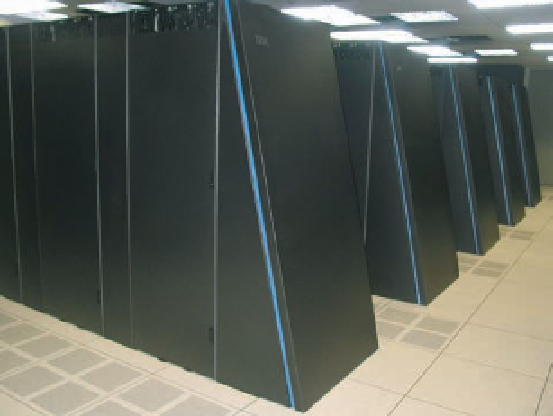Information Technology Reference
In-Depth Information
Blue Gene computers are in development including the BlueGene/C (sister project to
BlueGene L and scheduled to be released in 2007 but delayed), BlueGene/P (designed to
run at a speed of 1 to 3 PetaFLOPS), and BlueGene/Q (targeted to achieve 10 PetaFLOPS
by 2012). Table 3.5 compares the processing speeds of supercomputers.
Table 3.5
Speed
Meaning
Supercomputer Processing
Speeds
GigaFLOPS
1 x 10
9
FLOPS
TeraFLOPS
1 x 10
12
FLOPS
PetaFLOPS
1 x 10
15
FLOPS
Scientists say that these supercomputers will enable more realistic computer simulations
that will provide new insights into new drug development, geology, climate change, dark
matter, and other mysteries of the universe. “They are a tool that really helps stimulate the
imagination of scientists and engineers in ways that weren't previously possible,” according
to David Turek, vice president of supercomputing at IBM. “Nature is the final arbiter of
truth,” says Mark Seager, a Lawrence Livermore computer scientist, but “rather than doing
experiments, a lot of times now we're actually simulating those experiments and getting the
data that way.”
61
IBM's Blue Gene/L System at the
Lawrence Livermore National
Laboratory is the fastest
supercomputer in the world and can
perform 596 trillion floating-point
operations per second.
(Source: Courtesy of IBM
Corporation.)
In an effort to keep the United States in the forefront of supercomputing, the Defense
Advanced Research Projects Agency (DARPA) awarded $250 million to both Cray and
IBM to develop so-called Petascale computers by 2010 capable of achieving 2 PetaFLOPS
of sustained performance. According to Dr. William Harrod, DARPA program manager,
“High-productivity computing is a key technology enabler for meeting our national security
and economic competitiveness requirements. High-productivity computing contributes sub-
stantially to the design and development of advanced vehicles and weapons, planning and
execution of operational military scenarios, the intelligence problems of cryptanalysis and
image processing, the maintenance of our nuclear stockpile, and is a key enabler for science
and discovery in security-related fields.”
62





